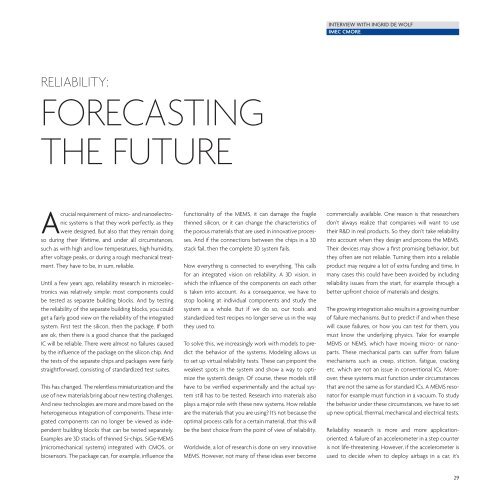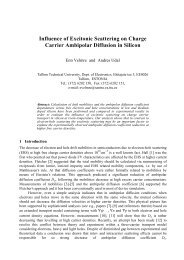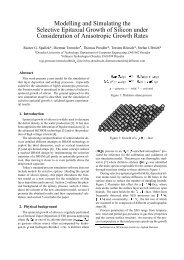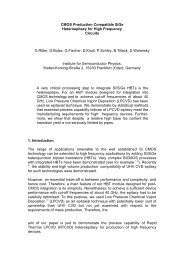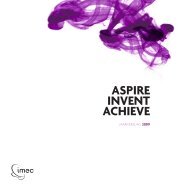Annual report 2009 - Imec
Annual report 2009 - Imec
Annual report 2009 - Imec
You also want an ePaper? Increase the reach of your titles
YUMPU automatically turns print PDFs into web optimized ePapers that Google loves.
RELIABILITy:<br />
FORECASTINg<br />
THE FUTURE<br />
A<br />
crucial requirement of micro- and nanoelectronic<br />
systems is that they work perfectly, as they<br />
were designed. But also that they remain doing<br />
so during their lifetime, and under all circumstances,<br />
such as with high and low temperatures, high humidity,<br />
after voltage peaks, or during a rough mechanical treatment.<br />
They have to be, in sum, reliable.<br />
Until a few years ago, reliability research in microelectronics<br />
was relatively simple: most components could<br />
be tested as separate building blocks. And by testing<br />
the reliability of the separate building blocks, you could<br />
get a fairly good view on the reliability of the integrated<br />
system. First test the silicon, then the package. If both<br />
are ok, then there is a good chance that the packaged<br />
IC will be reliable. There were almost no failures caused<br />
by the influence of the package on the silicon chip. And<br />
the tests of the separate chips and packages were fairly<br />
straightforward, consisting of standardized test suites.<br />
This has changed. The relentless miniaturization and the<br />
use of new materials bring about new testing challenges.<br />
And new technologies are more and more based on the<br />
heterogeneous integration of components. These integrated<br />
components can no longer be viewed as independent<br />
building blocks that can be tested separately.<br />
Examples are 3D stacks of thinned Si-chips, SiGe-MEMS<br />
(micromechanical systems) integrated with CMOS, or<br />
biosensors. The package can, for example, influence the<br />
functionality of the MEMS, it can damage the fragile<br />
thinned silicon, or it can change the characteristics of<br />
the porous materials that are used in innovative processes.<br />
And if the connections between the chips in a 3D<br />
stack fail, then the complete 3D system fails.<br />
Now everything is connected to everything. This calls<br />
for an integrated vision on reliability. A 3D vision, in<br />
which the influence of the components on each other<br />
is taken into account. As a consequence, we have to<br />
stop looking at individual components and study the<br />
system as a whole. But if we do so, our tools and<br />
standardized test recipes no longer serve us in the way<br />
they used to.<br />
To solve this, we increasingly work with models to predict<br />
the behavior of the systems. Modeling allows us<br />
to set up virtual reliability tests. These can pinpoint the<br />
weakest spots in the system and show a way to optimize<br />
the system’s design. Of course, these models still<br />
have to be verified experimentally and the actual system<br />
still has to be tested. Research into materials also<br />
plays a major role with these new systems. How reliable<br />
are the materials that you are using? It’s not because the<br />
optimal process calls for a certain material, that this will<br />
be the best choice from the point of view of reliability.<br />
Worldwide, a lot of research is done on very innovative<br />
MEMS. However, not many of these ideas ever become<br />
INTERVIEW WITh INGRId dE WoLf<br />
IMEC CMORE<br />
commercially available. One reason is that researchers<br />
don’t always realize that companies will want to use<br />
their R&D in real products. So they don’t take reliability<br />
into account when they design and process the MEMS.<br />
Their devices may show a first promising behavior, but<br />
they often are not reliable. Turning them into a reliable<br />
product may require a lot of extra funding and time. In<br />
many cases this could have been avoided by including<br />
reliability issues from the start, for example through a<br />
better upfront choice of materials and designs.<br />
The growing integration also results in a growing number<br />
of failure mechanisms. But to predict if and when these<br />
will cause failures, or how you can test for them, you<br />
must know the underlying physics. Take for example<br />
MEMS or NEMS, which have moving micro- or nanoparts.<br />
These mechanical parts can suffer from failure<br />
mechanisms such as creep, stiction, fatigue, cracking<br />
etc. which are not an issue in conventional ICs. Moreover,<br />
these systems must function under circumstances<br />
that are not the same as for standard ICs. A MEMS resonator<br />
for example must function in a vacuum. To study<br />
the behavior under these circumstances, we have to set<br />
up new optical, thermal, mechanical and electrical tests.<br />
Reliability research is more and more application-<br />
oriented. A failure of an accelerometer in a step counter<br />
is not life-threatening. However, if the accelerometer is<br />
used to decide when to deploy airbags in a car, it’s<br />
29


